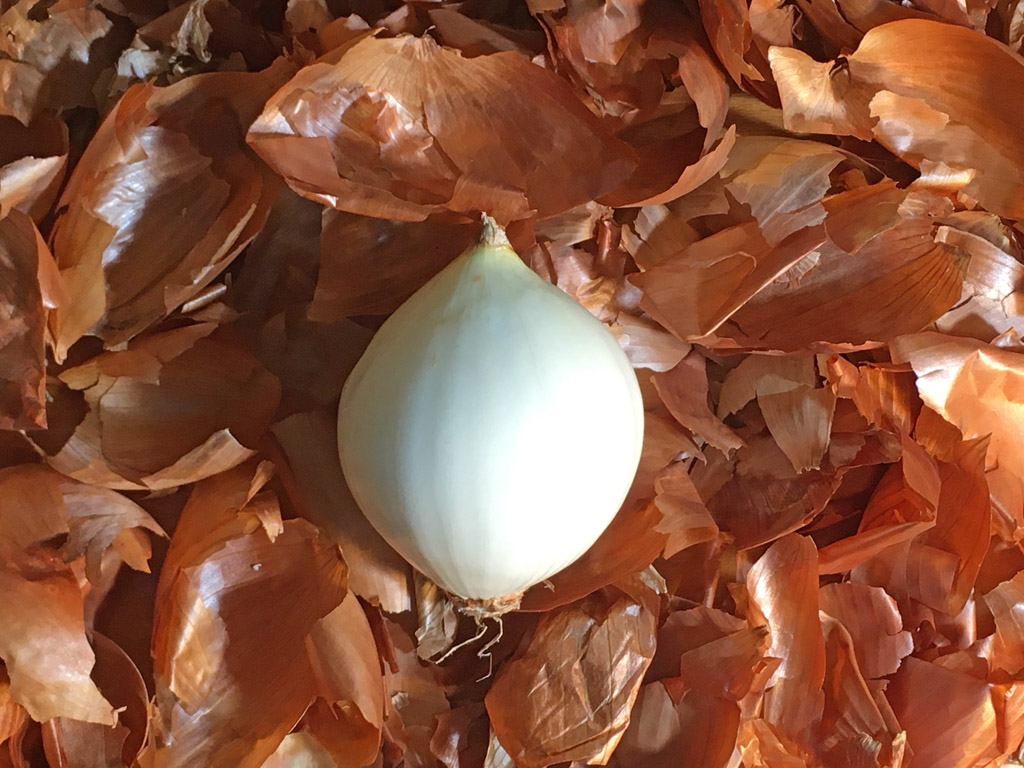Long ago, when it was customary to report daily to an office for work, I found myself plotting a mild act of protest against the banality of office culture.
One day, in plain view of my coworkers, I would silently stage this protest, which would be known only to me. No, I would not be so bold as to visibly depart from the de facto dress code, which for men, seemed to consense on a collared, button-up shirt, tucked in to a pair of casual slacks or reasonably dark jeans. Yes, on this day I would stroll into the office as usual — in fact, sporting a nicer-than-usual, smart and crisply ironed dress shirt, single-needle tailored, 100 percent cotton, Oxford pinpoint — the very best that J.C. Penney had to offer.
But I would have done something very, very sneaky.
This shirt would have been dyed with onion skins.
Yes, I was going to stage my own, private, Take Your Kitchen Scraps to Work Day. My boss might stride in, screaming, “Mike! We need that report right away!” And I would say, “Yes, sir!” And after he left, I would think to myself, “He had no idea that my shirt was dyed with onion skins.”
And the next time one of the office know-it-alls came up to my cube and bent my ear about something which he or she seemed to know far too much about, I could silently tell myself, “Yes, but one thing you don’t know is that my shirt was dyed with onion skins.”
Changed priorities
All this is caricature, of course. I like my coworkers. But years of compulsory office work does something unhealthy to a person. This idea that seemed so pleasantly and innocently subversive then, seems much less meaningful now, working largely at home after the pandemic. I no longer feel a lack of agency in choosing how I conduct my work days, or how I dress for them. I only come to the office on Fridays now, when there is rarely another human being to interrupt my work flow, much less examine my attire. There are gives and gets, but all in all, I think it’s a better world.
But I forgot to stop collecting onion skins.
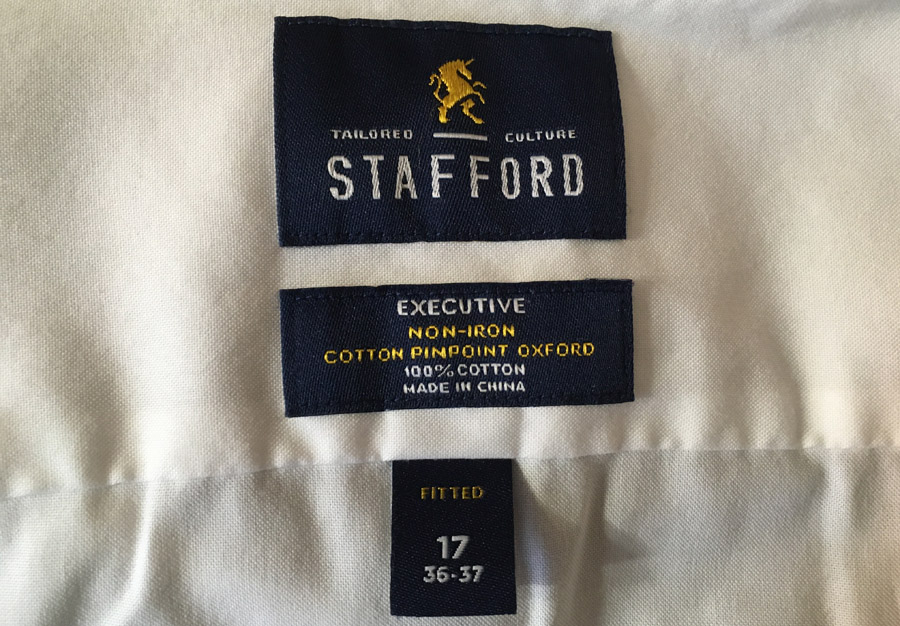
What brown can do for you
Ever since I was a child, I have known that onion skins can be used to dye things — as long as you want them to be brown. One Easter Sunday, when my parents were too broke even to buy Easter egg dye, my mother rescued the occasion by going to the pantry and scrounging around the onion bin, relieving what few onions that remained of the loose parts of their skin. She then boiled these in some water for a bit, and placed the eggs in to boil along with it. After a while, to my amazement, they had all turned a deep, rich, orangey brown. I thought she was a magician.
I’m not sure that the PAAS Easter Egg Dye Kit that we couldn’t afford even included a brown among its bright blues, reds, and greens. But when you’re poor, you can still have brown. It was something other than plain old white, at least, and it was pretty cool.
I later learned that all sorts of things could be dyed with onion skins, and the color more often ranges from yellow to orange and yes, even brown. The hardest part was saving up enough skins.
When I first thought of dyeing a dress shirt, suddenly no onion skin could escape my kitchen. But it wasn’t clear how many I would need to collect, so I just kept collecting.
Recently, I noticed that I had saved nearly two pounds of onion skins — no small feat for a substance that weighs almost nothing, and certainly far more than needed. Needed for what? Oh yes, that dress shirt thing I was going to do, someday.
Had this become a hoarding obsession? Was I going to die with a kitchen full of onion skins, and a closet full of old white shirts, unworn since 2019?
It was time to do it. So yesterday, I did it.
How I did it
You will need:
- 100 grams onion skins
- 3.5 gallons cold water
- 1 tablespoon salt
- Two 5-gallon stainless steel pots
- strainer
- cheesecloth
- One blindingly white 100% cotton dress shirt, or similar item.
Preparation time: Several years to collect the onion skins. Then about 2 hours.
First, I weighed out the onion skins. I had no idea how much it would take, and surfing the web only confused things. A lot of people have bragged online about dyeing fabric with onion skins, but their recipes are maddeningly imprecise. Even when they weigh the skins, they invariably say, “cover the onion skins with water.” But onion skins are not beans. You can’t cover them with water, because they float.
So I settled on an even 100 grams of onion skins, a generous fraction of what I had saved. To these I added 3.5 gallons of water, simply because I wanted that much volume to float the shirt in. When dyeing it’s important to give the fabric plenty of space, so it can soak up the dye evenly without being twisted or compacted.
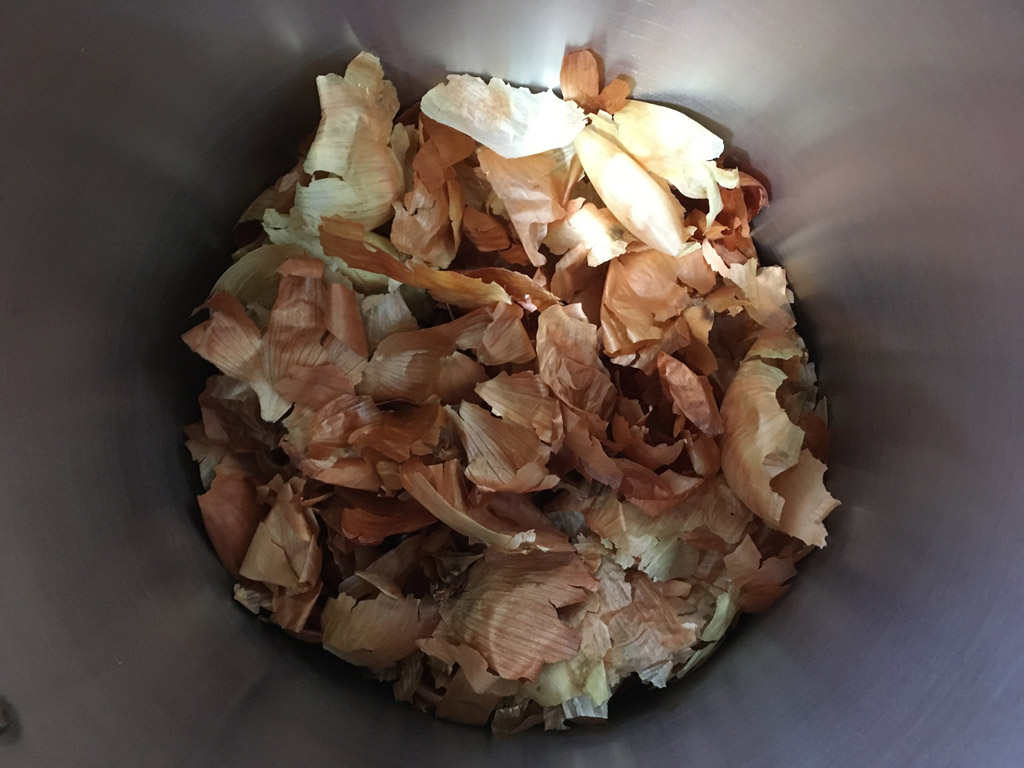
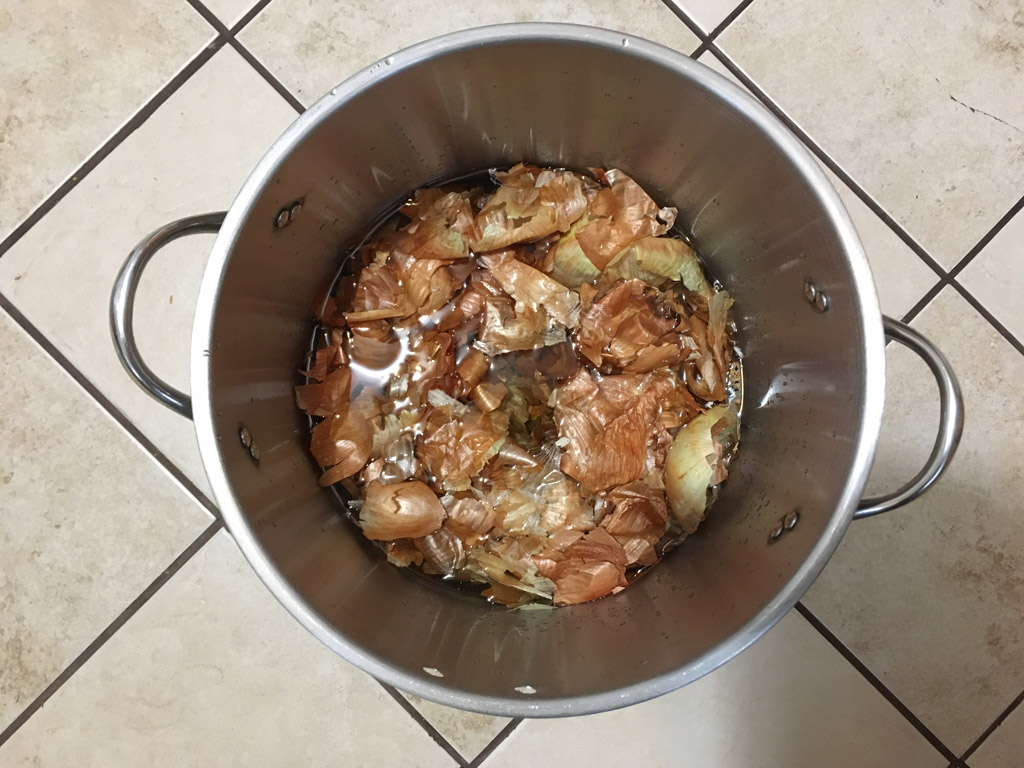
It took about 45 minutes to bring the mixture to a boil. Below, the water hasn’t even come to a boil yet, and the water is already taking on a strong golden color. So far, so good!
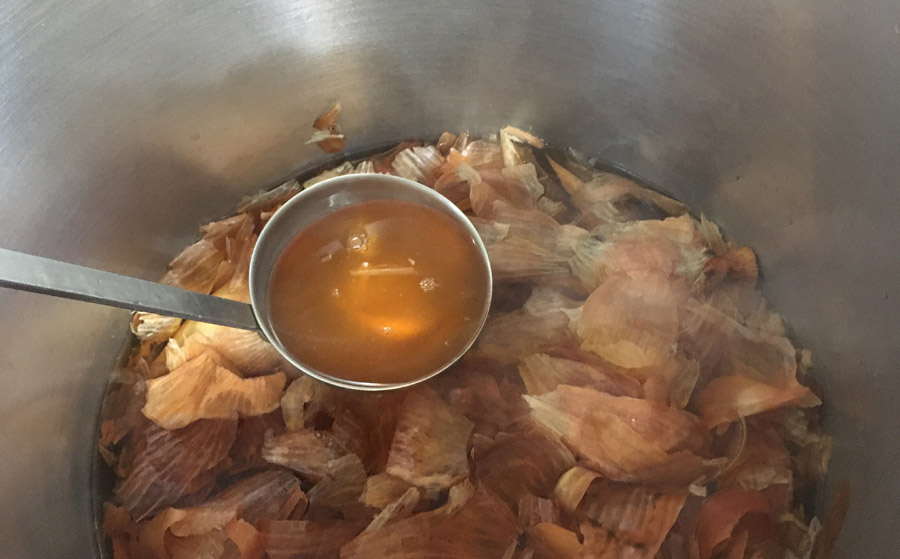
After it reached a boil, I put on the lid and turned down the heat, keeping it at a strong simmer. After about 30 minutes, the onion skins had sunk under the surface and the color had deepened considerably.

Finally, after an hour of simmering (in addition to the 45 minutes it took to reach a boil), it didn’t seem to be getting any darker, so I called it done.
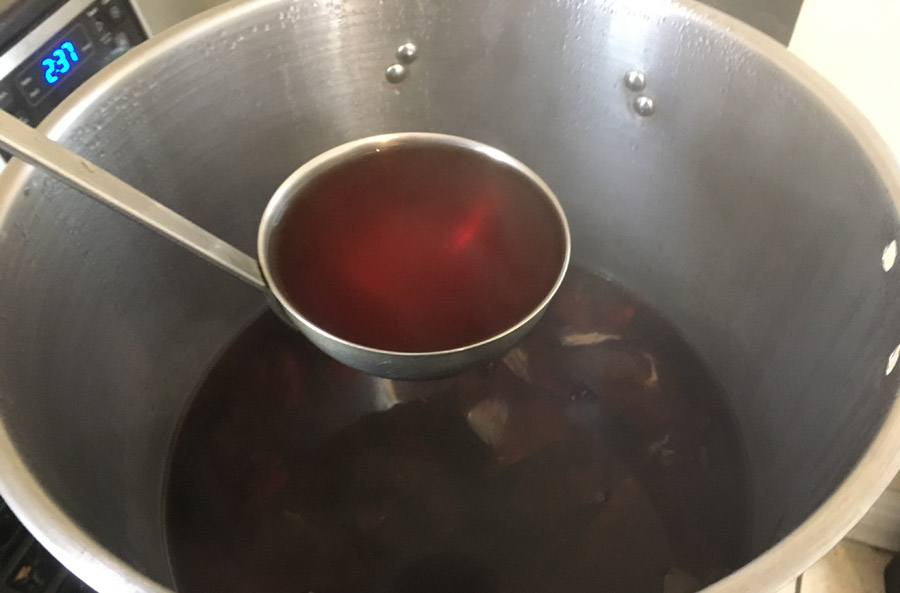
I then poured the mixture through a cheesecloth-covered sieve into another pot of the same size, being careful not to let any of the skins fall back into the dye. I also added a tablespoon of salt, which is rumored to help the dye achieve an even color.
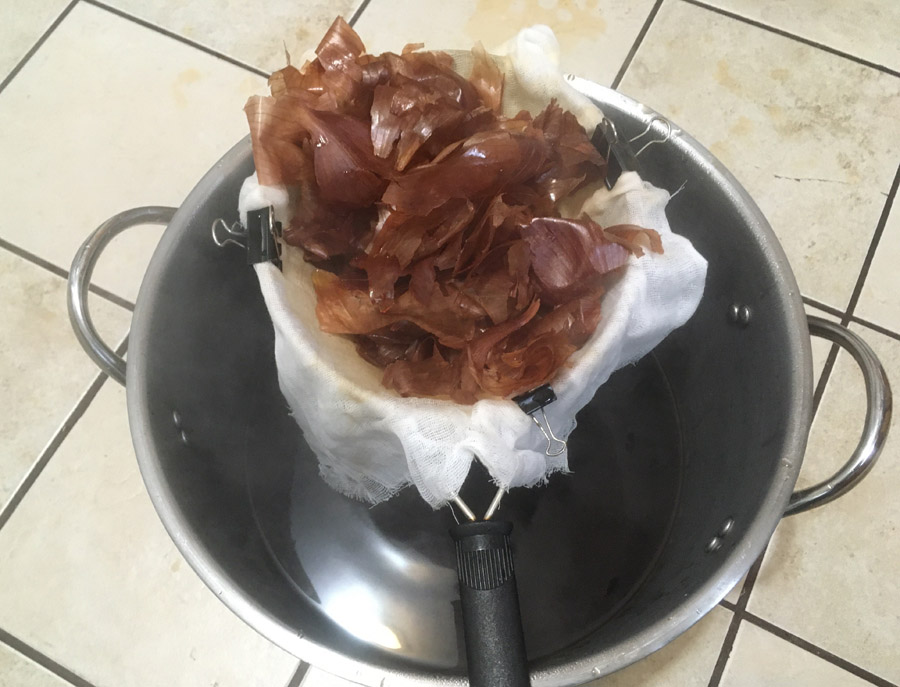
Then I placed the dye back on the burner, to bring it back to a boil. I also prepared the shirt by presoaking it in hot water, to help the dye permeate evenly.
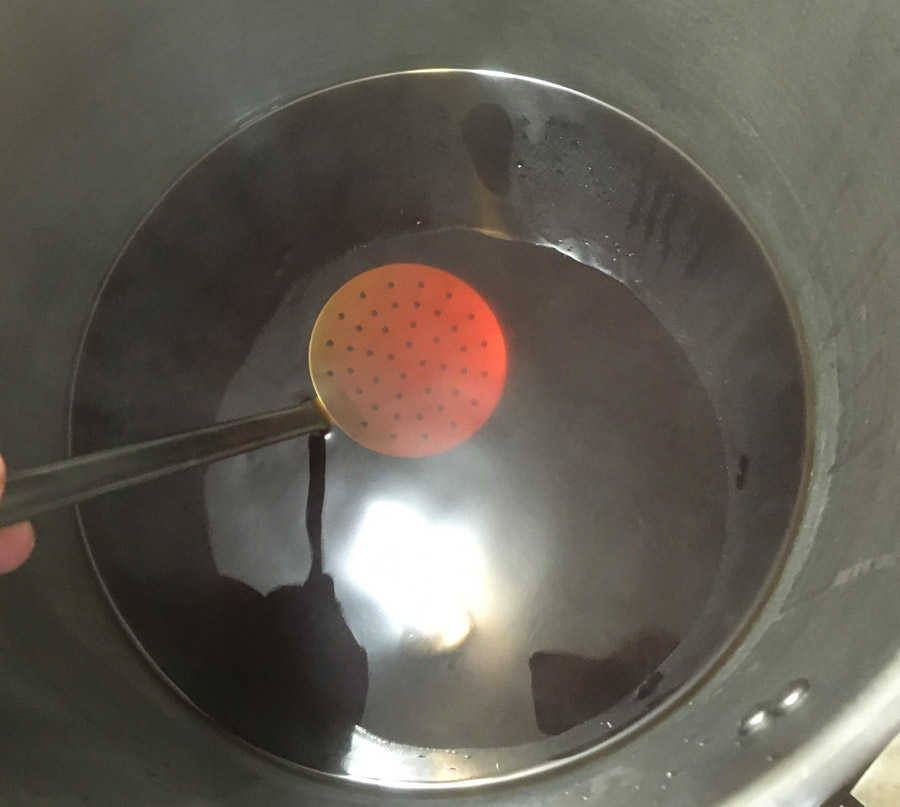
It was time to finally give the salaryman a dunk. Here goes!
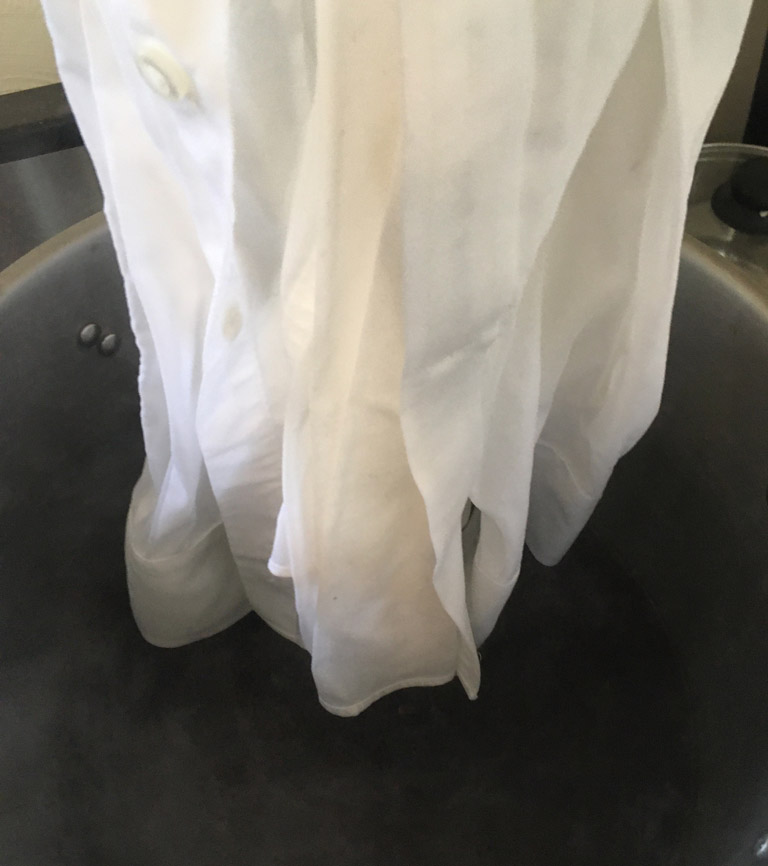
It’s important to keep the fabric moving while it’s in the dye bath, to get even coverage. Here’s how it looked after only a few minutes, attaining some much-needed character. I see a happy face, do you?
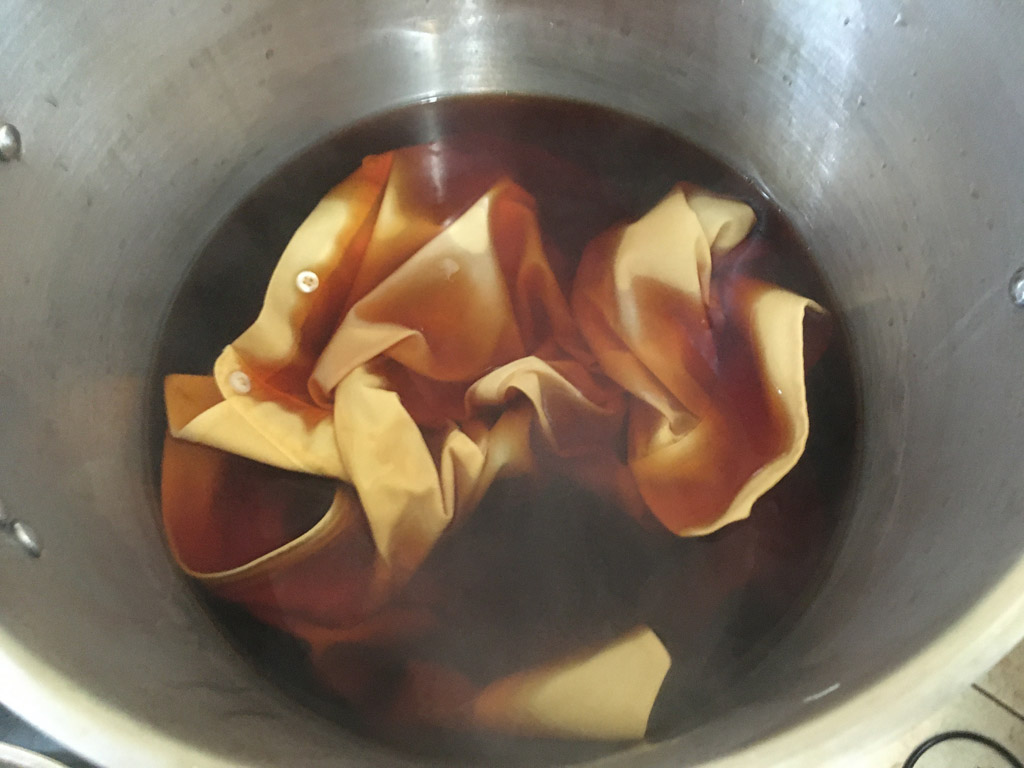
After about 15 minutes of swirling and stirring, I pulled out a sleeve to see where things were headed.
Isn’t that something! Whatever it’s going to be, it certainly won’t be white.
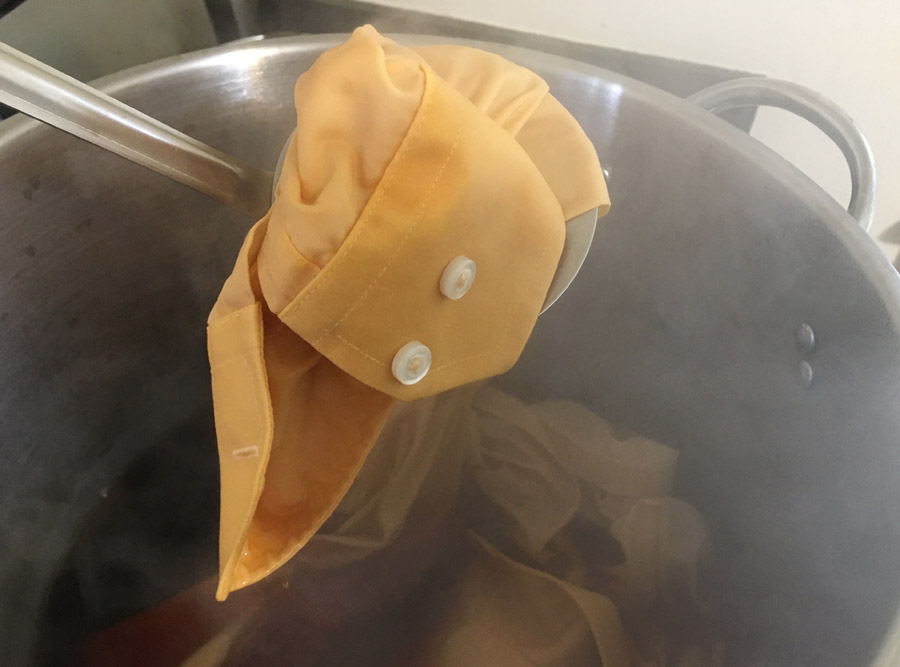
After an hour of continued heating and agitation, the color seemed to have reached its terminal saturation. I then pulled it out and rinsed it in two changes of warm water. After wringing it out, I placed it on a hanger and assessed what the onions had accomplished.
Well, that’s certainly something! I had not planned on dressing like a Tibetan monk. But with the right pants, it could work.
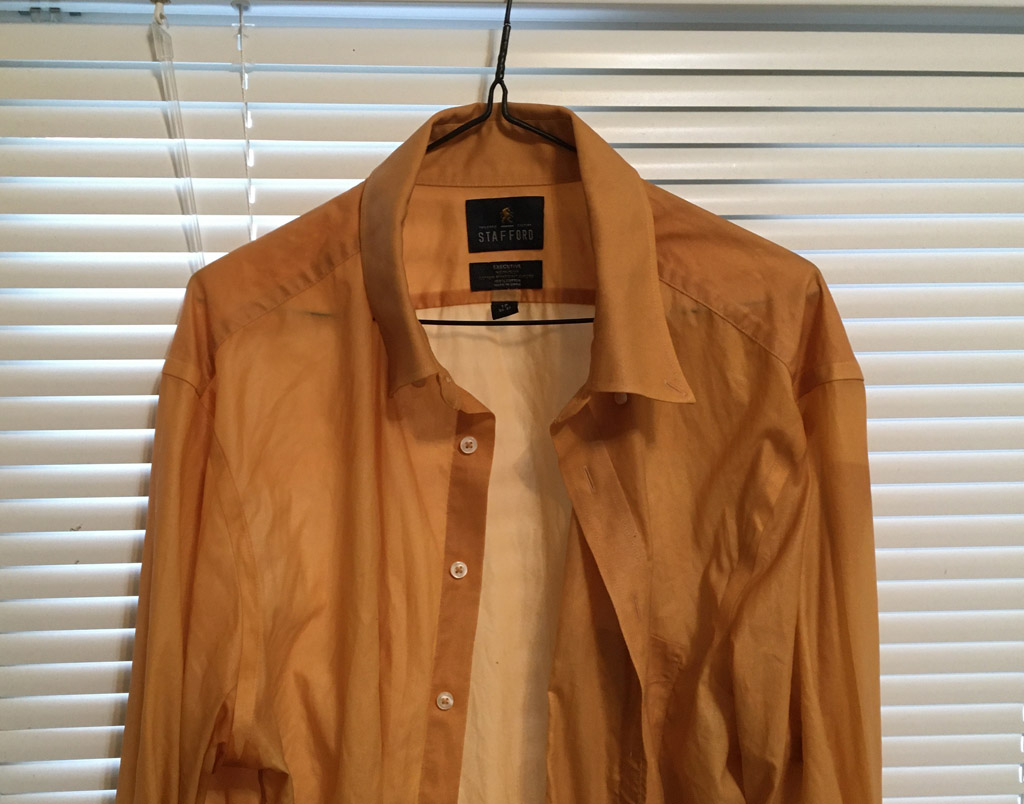
It would probably lighten up a bit after it dried. So I placed it in the dryer and hoped for the best.
As expected, when the shirt was dry it became a bit more subdued, moving away from saffron toward a subtle, pale orange. Quite tasteful, and a big improvement on the blinding white of before.
Yes, this will do. Nobody will suspect a thing.

Act two
Primary mission accomplished, I was now left with two gallons of warm orange dye. After such a long contemplation, I couldn’t bear to just pour it down the drain. I looked in my closet. A white cotton T-shirt? Within the hour, it was orange. White cotton socks? Yes, orange please.
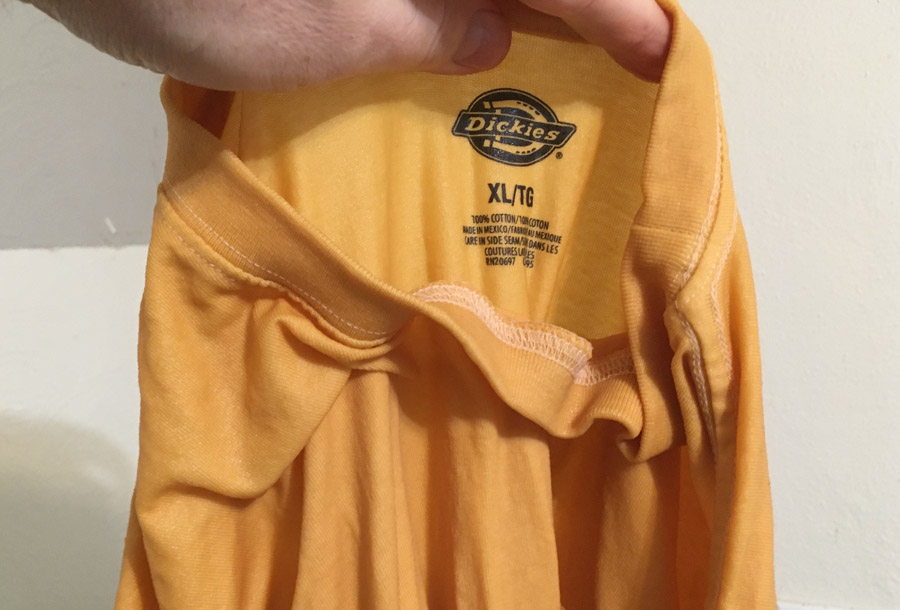
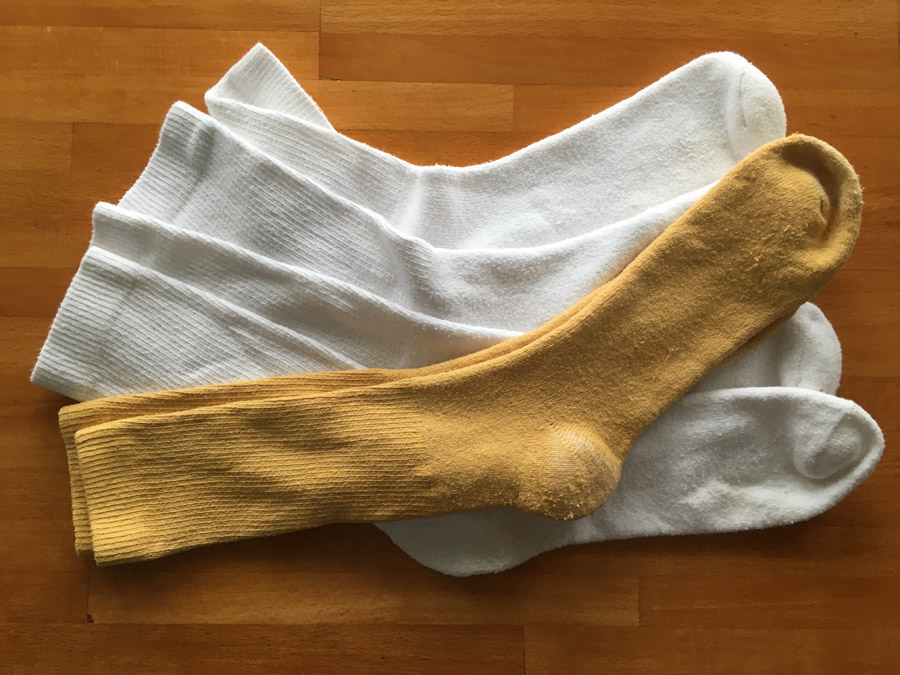
Again, when dry, these articles became a unique and rather pleasant yellow-orange, after only an hour in a lukewarm dye bath. They might have been darker had I left them overnight, but I was worried about the color becoming uneven if they were not periodically stirred. Although the socks had some polyester content, they dyed almost as well as the shirt. The polyester is visible mainly around the heels, which must have been reinforced with it. And even though the T-shirt was labeled 100% cotton, the stitching appears to be synthetic, as it did not absorb the dye at all. Thus a trained eye might detect that these articles are not the same color as when they left the factory. But they are perfectly passable, and unique.
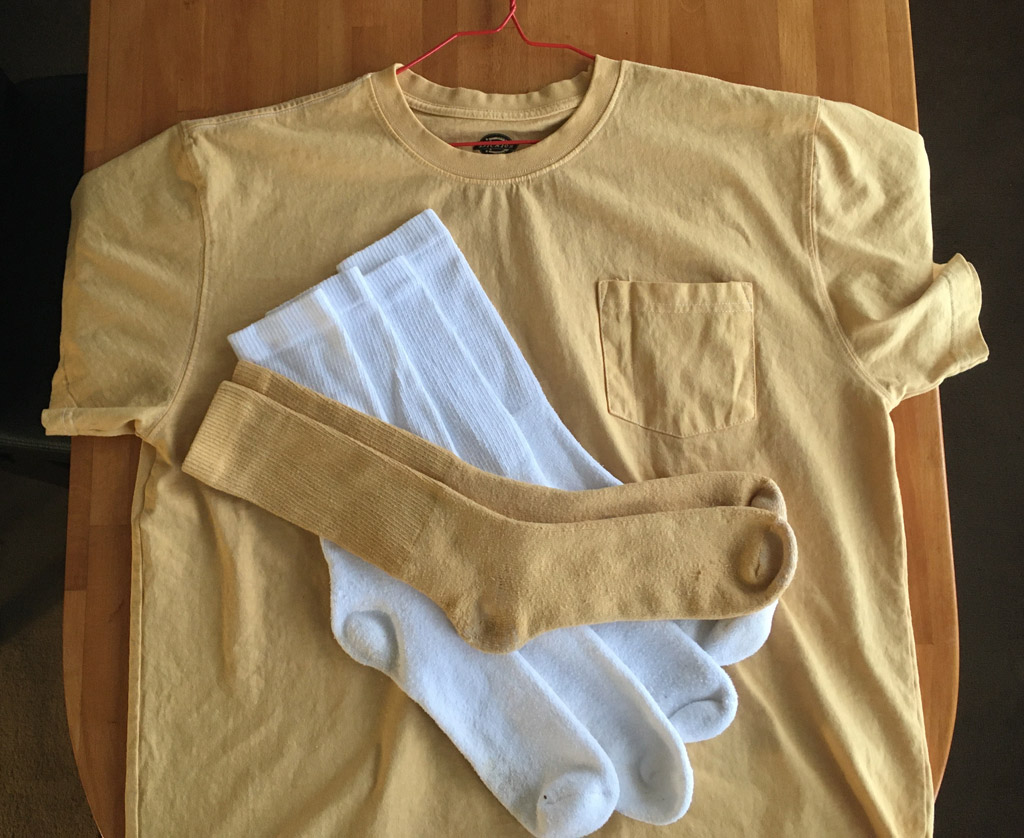
It remains to be seen how well the color will hold up to subsequent washing. You really can’t go wrong with socks and T-shirts, so I’m sure I’ll be pleased with whatever happens.
Probably too late
As for the dress shirt, it will be lounging among its straitlaced siblings, until the next business conference or on-site meeting that is worthy of its secretly subversive presence.
But in this post-pandemic world, where I’ve already attended several virtual meetings without wearing pants, I’m not sure it will be quite the same. More likely, I’ll end up spilling the beans and bragging to my in-person colleagues about how I achieved such an earthy shade of gold with nothing but onion skins. Oh well, times change — sometimes for the better.
But if you’d like to try it yourself, I could certainly spare a few onion skins.
(By the way, if you’d like to learn more about dyeing with waste products, I recommend this ad-free video from NHK: Japan; a fascinating way to spend 15 minutes).
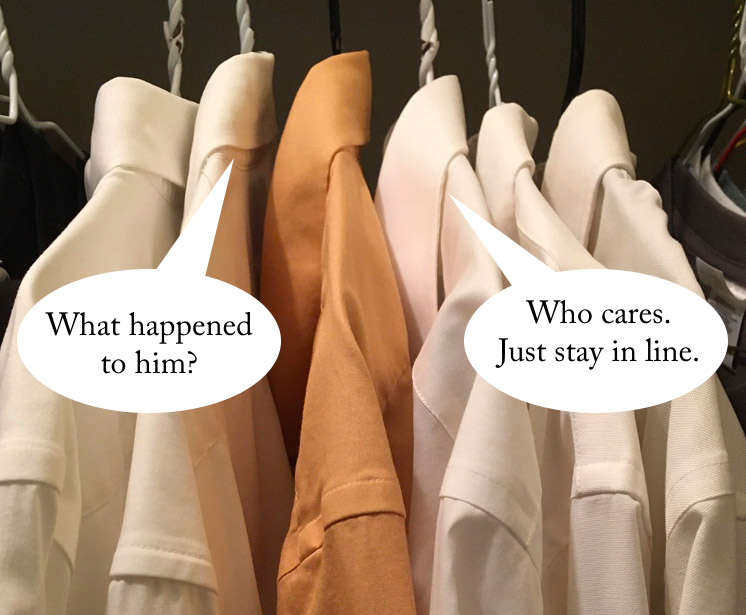
Article and photos Copyright 2022 by the author.
